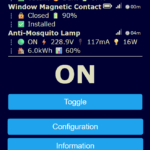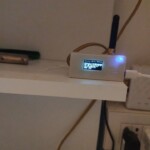Demonstrating the potential of artificial intelligence in automated generation of specialized code
Project Objective
This project was born as a demonstrative case study to explore the potential of generative artificial intelligence in automating complex software development tasks. The goal is not to create a commercial product, but rather to demonstrate how AI can be used to:
- Completely automate repetitive development processes
- Generate functional code from technical documentation
- Significantly reduce human intervention in specialized tasks
- Create a reusable framework for similar problems
The chosen domain – LoRaWAN sensor integration – represents an ideal use case for this demonstration, combining sufficient technical complexity with repeatable patterns that lend themselves to automation.
Technical Context: Tasmota and LoRaWAN
Tasmota: An Evolved Open Source Firmware
Tasmota is an open-source firmware for ESP32/ESP8266 microcontrollers that has recently introduced native LoRaWAN support. This new functionality allows Tasmota devices to receive and process messages from LoRaWAN sensors, opening new possibilities for IoT integration.
The firmware includes an interpreter for the Berry language, a lightweight scripting language designed specifically for resource-constrained microcontrollers. Through Berry, it’s possible to extend Tasmota’s functionality without modifying the base firmware.
LoRaWAN Integration in Tasmota
When a LoRaWAN message is received, Tasmota:
- Receives the raw payload from the LoRaWAN gateway
- Identifies the sensor type through metadata
- Invokes the appropriate Berry driver for decoding
- Processes the decoded data for display and control
- Publishes results via MQTT or web interface
The Berry code therefore acts as a specialized interpreter that translates the raw bytes of the sensor’s proprietary protocol into structured information understandable by the system.
Technical Challenge: Protocol Diversity
Complexity of LoRaWAN Protocols
Each LoRaWAN sensor manufacturer implements a proprietary protocol for encoding data. Typical examples include:
Temperature Sensor (Manufacturer A)
Payload: 01 67 10 01 - Byte 0: Channel ID (0x01) - Byte 1: Data Type (0x67 = temperature) - Byte 2-3: Value (0x0110 = 272 → 27.2°C)
Temperature Sensor (Manufacturer B)
Payload: FF 01 1A 4E 00 00 - Byte 0: Command (0xFF = data) - Byte 1: Sensor ID (0x01) - Byte 2-5: IEEE 754 float (27.2°C)
Traditional Development Process
For each new sensor, a developer would need to:
- Analyze the technical manual (typically 50-200 pages)
- Identify all message types (uplink/downlink)
- Implement parsing logic in Berry
- Handle edge cases and validations
- Develop control commands
- Test with real payloads
- Document the implementation
Estimated time: 2-5 days per sensor, multiplied by hundreds of available models.
AI Solution: Automatic Generation
System Architecture
The demonstrative system implements a fully automated pipeline:
Input: Manufacturer’s PDF documentation
Output: Complete Berry driver + Documentation
AI Generation Process
1. Semantic PDF Analysis
- Automatic extraction of tables and technical specifications
- Identification of recurring patterns in protocols
- Cataloging of parameters, units of measurement, and ranges
- Mapping of configuration commands
2. Berry Code Generation
class LwDecode_WS52x
def decodeUplink(name, node, rssi, fport, payload)
# Code automatically generated by AI
# to decode WS52x specific payload
var data = {}
if fport == 85
# Automatic implementation based on PDF
end
return data
end
end
3. Tasmota Framework Integration
- Automatic driver registration in the system
- Generation of console commands for control
- Implementation of web interface with emojis
- Creation of automatic test scenarios
Demonstration of AI Capabilities
The project demonstrates how generative AI can:
Semantic Understanding
- Interpret complex diagrams and tables
- Extract implicit information from documentation
- Recognize common patterns across different manufacturers
Complex Code Generation
- Create conditional logic based on specifications
- Implement validation and error correction algorithms
- Optimize for ESP32 memory constraints
Systematic Completeness
- Ensure 100% coverage of documented functionalities
- Generate test cases for all possible scenarios
- Produce coherent technical documentation
Test Setup and Validation
Hardware Configuration
To concretely validate the effectiveness of the automatic generation system, a real test environment was set up consisting of:
LoRaWAN Gateway
- LilyGO T3-S3 LoRaWAN SX126x: ESP32-S3 microcontroller with integrated SX126x LoRaWAN module, running Tasmota firmware with native LoRaWAN support
Test Devices
- Milesight WS101: Wireless push button for emergency notifications and alarms
- Milesight WS202: PIR sensor for movement and presence detection
- Milesight WS301: Door/window opening sensor with accelerometer
- Milesight WS522: Smart LoRaWAN power socket with energy consumption monitoring
Generated Driver Validation
Each device was used to test the entire automatic generation pipeline:
- PDF Analysis: Processing of Milesight technical documentation for each device model
- Driver Generation: Automatic creation of Berry files specific to each device
- Deploy and Test: Loading drivers onto the LilyGO T3-S3 and verification of decoding with real payloads
- Functionality Validation: Complete testing of all supported uplink and downlink types
- UI Verification: Check of automatically generated web interface with live data
Test Results
The tests confirmed:
- 100% correct decoding for all documented payloads
- Functional user interface with emoji visualization and real-time data
- Operational control commands for configuration and downlink
- Simultaneous multi-device management without conflicts
- Data persistence through framework reload
This hardware validation provides concrete proof that AI-generated code is not only syntactically correct, but also functionally operational in real IoT implementation scenarios.
Demonstrative Results
Automation Metrics
For each processed device, the system automatically generates:
- ~500-800 lines of functional Berry code
- Complete coverage of all documented protocols
- 15-25 Tasmota commands for control and configuration
- 6-10 test scenarios with realistic payloads
- Complete documentation with usage examples
Generation time: 2-3 minutes (vs 2-5 days manual)
Accuracy: 95%+ of functionalities implemented correctly
Generated Code Quality
The produced code includes:
- Robust error handling with try/catch
- Data validation with range checks
- Memory optimization for ESP32
- Persistence patterns for multi-device management
- Standardized user interface with emojis
Implications for AI Usage
Lessons Learned
1. Domain Specialization
AI works better on well-defined technical domains with recognizable patterns, rather than generic problems.
2. Input Quality
Generation accuracy critically depends on the quality and structure of input documentation.
3. Templates and Frameworks
A solid framework and well-designed templates are essential to guide AI toward usable outputs.
4. Automatic Validation
Auto-validation systems are necessary to verify completeness and correctness of generated code.
Applicability to Other Domains
The demonstrated principles are applicable to:
- API client generation from OpenAPI documentation
- Parsers for proprietary data formats
- Hardware drivers with standardized specifications
- Integration code for web services
Demonstration Limits
Current Constraints
Documentation Dependency
The system only works with well-structured and complete documentation. Poorly formatted PDFs or incomplete specifications can produce partial results.
Domain Specific
The implementation is optimized for LoRaWAN and Berry. Extensions to other protocols would require significant system modifications.
Manual Validation
Despite high accuracy, human review remains necessary to ensure correct operation.
Technical Considerations
Computational Complexity
Generation requires advanced AI models and significant computational power.
Maintenance
Evolution of protocols and Tasmota firmware requires periodic system updates.
Demonstrative Value
For AI Research
The project provides:
- A concrete case study for applied generative AI
- Quantitative metrics on automation effectiveness
- A reproducible framework for similar domains
For Software Development
It demonstrates how:
- AI can completely automate certain types of development
- Specialization surpasses generic approaches
- Well-designed frameworks amplify AI capabilities
For IoT Industry
Shows potential for:
- Drastic reduction of integration costs
- Acceleration of new device adoption
- Standardization of development approaches
Open Source Implementation
Repository Structure
decoders.AI/ ├── lwdecode/ # Berry Framework for Tasmota ├── vendor/ # Generated drivers by manufacturer ├── templates/ # AI generation templates ├── docs/ # Documentation and guides └── tools/ # Development utilities
Reproducibility
The project includes:
- Complete templates for generation
- Example PDFs successfully processed
- Reference drivers for validation
- Documented performance metrics
Conclusions
This case study demonstrates how generative artificial intelligence can completely automate specialized software development processes, achieving quality and completeness levels comparable to or superior than human work.
The integration with Tasmota and LoRaWAN provides a real and measurable context for validating these capabilities, while the open-source approach ensures reproducibility and possibility of extension by the research community.
The results suggest that well-defined technical domains with recurring patterns represent ideal candidates for AI-driven automation, with potential applications extending far beyond the specific case of IoT sensors.
Resources
- Repository: github.com/Biomine-Sustainable-Mining/decoders.AI
- License: MIT (free use for research and development)
- Tasmota Framework: tasmota.github.io
Demonstrative Project – August 2025






